
views
Measuring and Cutting Fabric
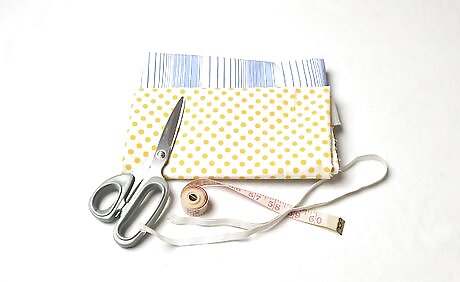
Gather your materials. Making a tiered skirt is an easy, quick project, but you will need to have all of your materials ready to go before you begin. You will need: Fabric in the colors and prints of your choice. You can use different colors or prints, or just one type if you only want the layered look. A sewing machine. Scissors. Measuring tape. A ½” to ¾” wide piece of elastic long enough to go around your skirt’s waistband.
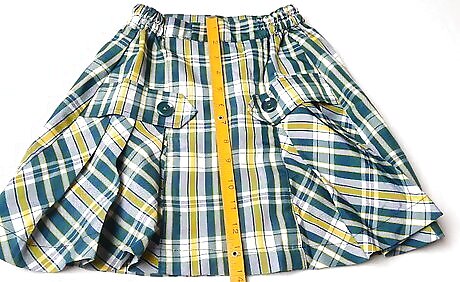
Determine the length of your skirt. You can make your tiered skirt any length you want it to be. However, you will need to know how long you want your skirt to be before you get started. This measurement is important for cutting your fabric and ensuring that your pieces are even. To determine how long you want your skirt to be, you can use a skirt that is the length you want your tiered skirt to be. Measure the skirt from the waist to the bottom hem and add 4” to this number to account for the hem, seams, and waistband. You can also measure the length on yourself or the person for whom you are making this skirt. Measure from the natural waist to the spot where you want the skirt to end and add 4” for the hem, seams, and waistband. If you plan to make your skirt with more than three tiers, then you will need more than 4" of extra fabric to work with. Add an extra inch for each additional tier. For example, if you want a four tiered skirt, then add an additional 5" inches to your length total. If you want to make a five tiered skirt, then add 6" to your length total, and so on.
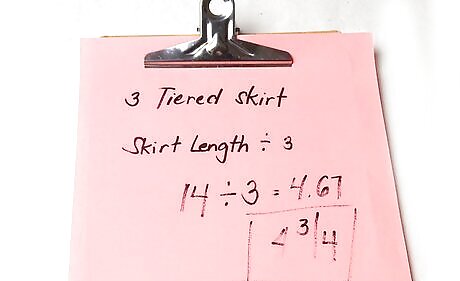
Divide the length. After you have your length, you will need to divide this number by the number of tiers that you want your skirt to have to get the length measurement for each of your pieces. To get this number, divide the total number of tiers you want and write it down. For example, if your total skirt length is 30”, and you want to make a three tiered skirt, then you would divide 30” by 3 and get 10”. That means that each of your pieces will need to be 10” long. To add more tiers to your skirt, divide your total length by the number of tiers you want. For example, if you wanted to create a five tiered skirt, then you would divide the total skirt length by 5. For example, if your total length is 35” and you want a five tiered skirt, then you would divide 35” by 5 for a result of 7” per piece.
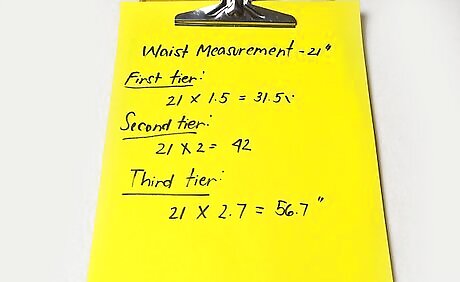
Calculate the width of each tier. Each of your tier pieces will need to be a different width to ensure that the skirt flows outwards towards the bottom. To determine how wide to make each piece, you will need to know the waist measurement for the person who will be wearing this skirt. Measure the person’s waist and record this number. Then, you will need to use a different equation for each tier. For example, if creating a three tiered skirt, then you would need to: Multiply the waist measurement by 1.5 for the first tier. Therefore, if the person’s waist is 30”, then the first tier will need to be 45” wide. Multiply the waist measurement by 2 for the second tier. For example, if the person’s waist is 30”, then the second tier will need to be 60” wide. Multiply the waist measurement by 2.7 for the third tier. So, if the person’s waist is 30”, then the third tier will need to be 81” wide. EXPERT TIP Daniela Gutierrez-Diaz Daniela Gutierrez-Diaz Clothing Designer Daniela Gutierrez-Diaz is a professional pattern maker and clothing designer at DGpatterns in Vancouver, Canada. With over 5 years of experience, Daniela creates modern and unique silhouettes that are suitable for a busy everyday life. Her blog, On the Cutting Floor, contains sewing tips and PDF sewing patterns for a variety of projects and designs. Daniela Gutierrez-Diaz Daniela Gutierrez-Diaz Clothing Designer The extra length of the tiers will allow you to add gathers to the skirt. Professional pattern-drafter Daniela Gutierrez-Diaz says: "When you're making a 3-tiered skirt, the first tier should be about 1.5 times your waist measurement. That way, you have room to put in gathers and elastic. The second tier should be about twice your waist length, and the third one should be about 2.5 your waist length."
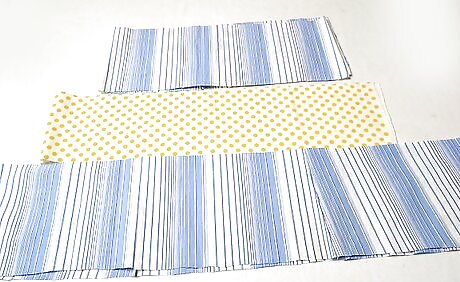
Measure and cut your fabric. After you have your measurements, measure and cut your fabric. Use the divided length measurement and the tier width measurements to determine the dimensions of your pieces. When you have measured each piece, cut the fabric according to these dimension. For example, if you are making a three tiered skirt for someone who has a 30” waist and wants the skirt to be 26” (total of 30” with added 4” for hem, seams, and waistband) long, then your measurements would be 10” by 45” for the first tier, 10” by 60” for the second tier, and 10” by 81” for the third tier. If you are using multiple kinds of fabric, then consider which one you want to be the top, middle, and bottom tier before you start cutting.
Sewing the Pieces Together
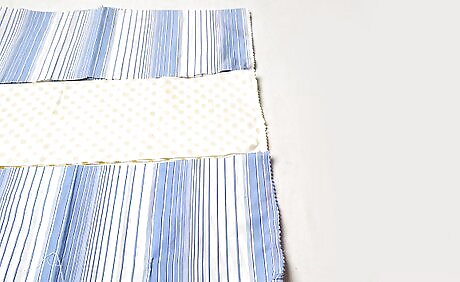
Sew the ends together. Fold over each of your fabric pieces so that the short ends are lined up and the right sides (print or color sides) are facing each other. Then, sew along the short edges to form each piece into a circle. If you prefer, you can wait to add a seam on the skirt until after you have sewed all of the tiers together. This may be a better option if you are planning to do more than three tiers.
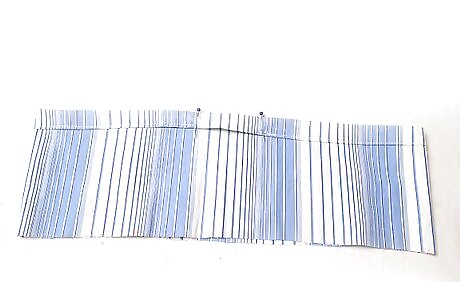
Fold over edge of top piece and sew. Take your top tier piece and fold over about ½” to 1” (depending on the width of your elastic) of fabric of one of the long edges so that the wrong sides (non-print or non-color sides) are facing each other. This will be the waistband of your skirt. Sew along this edge to create the waistband. Make sure to leave enough space to add your elastic in later. Leave a small 1” to 2” gap in the seam to insert the elastic.

Create the bottom hem. It is easier to hem the bottom of your skirt before you start to gather your pieces and sew them together. Fold over about ½” of fabric of one of the long edges of the bottom piece (your largest tier). Then, sew along this edge to create the bottom hem.
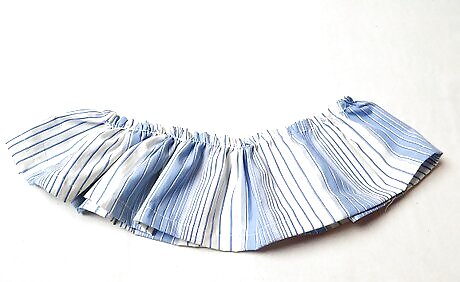
Add baste stitch to bottom tier. You will be sewing the tiers together, but first you need to gather them. You will start by gathering the bottom tier and sewing it onto the bottom of the middle tier. To gather the bottom tier, sew a baste stitch into the top of the bottom tier (not the edge that you just hemmed). If you want, you can sew a permanent stitch over the baste stitch when it is gathered to your liking. However, sewing the middle tier to the bottom tier will create this permanent stitch, so it is not absolutely necessary to stitch over the baste stitch.
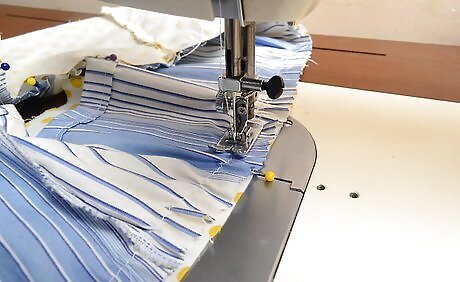
Pin and sew the bottom tier to the middle tier. Line up the edges so that the right sides of your fabric are facing each other. Then, pin along these edges about ¼” to ½” inch from the edge of the fabric. Be sure to line up the center seams on the bottom and middle tiers. If you did not create the center seam yet, then make sure that the ends are even. You can adjust the gathering before you start pinning the pieces together to make sure that the pieces are the same length. After you have pinned all the way around the pieces, sew the pieces together, removing the pins as you sew.
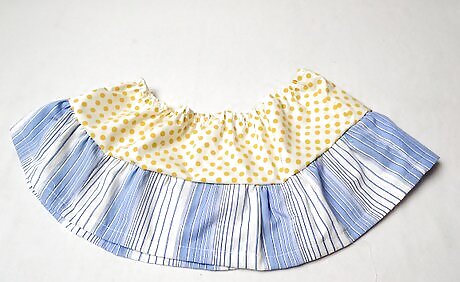
Create a baste stitch on top of middle tier. Next, you will need to repeat the baste stitch on the top of your middle tier, but this time you will be gathering the fabric so that it is the same size as your top tier piece. Add your baste stitch and then adjust until the middle tier piece matches your top tier piece.
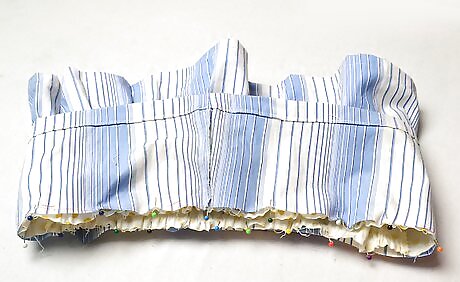
Pin and sew the middle tier to the top tier. After you have gathered the middle piece to match the top tier piece, begin pinning the wrong sides together. Pin all the way around the pieces and then sew the two pieces together. Make sure that you line up the center seams on the middle and top tiers. Remove the pins as you sew. If you have more than three tiers, then you will need to continue to baste and stitch until you have added all of your tiers.
Adding the Elastic
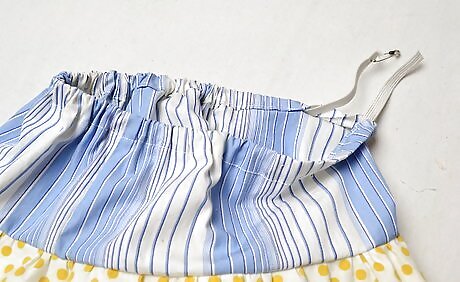
Slide elastic into gap in waistband seam. To finish your skirt, you will need to add the elastic to the waistband. Slide your elastic piece in through the gap that you left in the waistband at the beginning. Then, use your fingers to work the piece through the entire waistband. It can take a while to work the piece of elastic through the waistband. Attaching a safety pin to the end of the elastic before you insert it into the waistband may help you to pull it through a bit easier.
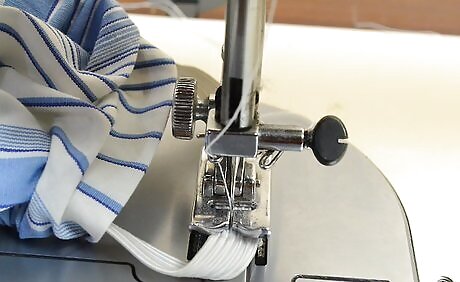
Sew the elastic ends together. After you have pulled the end of your elastic through the other end of the waistband and it is going all the way around the waistband, sew the two ends of the elastic together. This will secure the elastic in a circle inside of your fabric waistband.
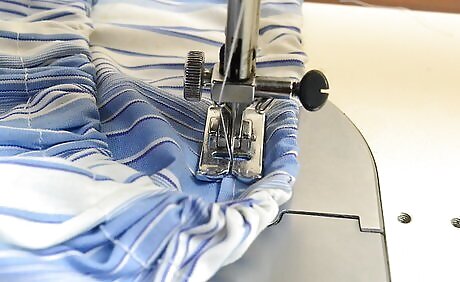
Close the open edge of the seam. After you have sewed the two ends of the elastic together, close the opening in the fabric waistband by sewing the gap closed. After the gap is closed, you can trim away any excess thread and your skirt is ready to wear!
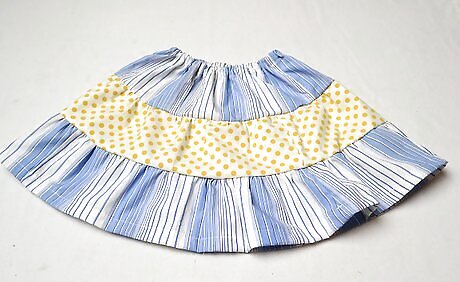
Finished.

















Comments
0 comment